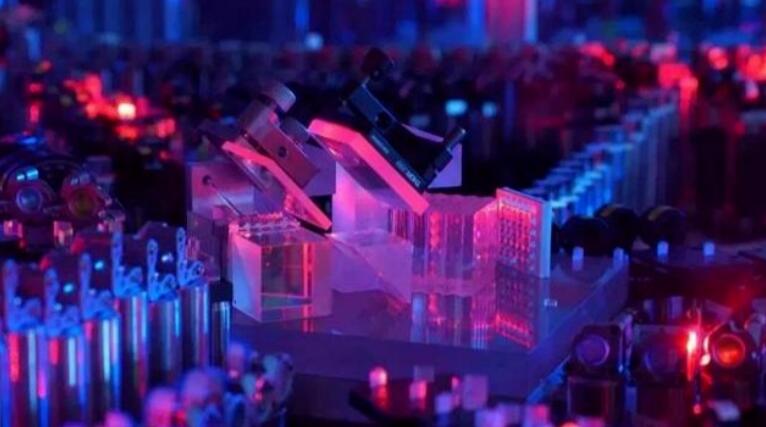In the early nineteenth century, the perfect building of classical physics was built, and people even began to wonder whether physicists were needed in the future. However, there are “two dark clouds” that cannot be explained, one of which is the ultraviolet disaster of black body radiation. In order to explain this phenomenon, combined with the existing research on the spectrum of hydrogen atoms, quantum mechanics turned out to be. A hundred years later, as an application of the principles of quantum mechanics, what is the progress of quantum computing and how will it develop?
01What is a quantum computer?
Quantum mechanics points out that in the microscopic world, energy is discretized. It feels like you keep zooming in on the inclined plane with a microscope, and finally find that all the inclined planes are made up of small steps. The word “quantum” also originated from this concept. “Quantum” is not a kind of particle. It refers to the phenomenon of energy discretization in the microscopic world. This concept corresponds to the “classical” and “continuous” in the macroscopic world.
Quantum computer refers to a computer that applies the principles of quantum mechanics to perform calculations. Correspondingly, the computers commonly used in our daily lives are called classic computers. Classical computers use digital signals 0 and 1 for calculations. A 0 or 1 is called a bit or a bit. Students who have studied math and electricity know that this bit is defined by the switch of the transistor in the chip. The quantum computer correspondingly uses qubits |0> and |1> for calculation, which can be defined by the two electronic energy levels in the atom or the two oscillation modes in the superconducting circuit. Different from the non-zero or one of the classical bit, the qubit can be in the quantum superposition state a|0>+b exp(iφ)|1>. And because quantum mechanics requires normalization of a and b, a?+b?=1, it can be roughly considered that two real numbers b/a and Φ can describe a qubit. Furthermore, if there are two qubits, they can be in the superposition state a|00>+b exp(iφ_1) |01>+ceiΦ2|10>+deiΦ3|11>, the real number needed to describe it becomes 6 A. It can be found that in order to describe a multi-bit quantum state, the required real numbers increase exponentially, which also makes classical computers quickly unable to simulate a quantum computer with dozens of bits. The quantum computer can easily manipulate this quantum state through some quantum gate circuits, which has also become the source of the advantage of quantum computers. Simply think, if you need to know the properties of a function f whose independent variable is n classical bits, the worst case of classical calculation needs to count all possible inputs, from f(00…0) to f(11… 1) It needs to be counted 2 times. However, quantum computing can directly calculate a superposition state |00…0>+…+|11…1>, and a superposition state of all results can be obtained |f(00…0)>+…+|f(11…1) >, which has all the information of this function f. Taking advantage of the unique characteristics of quantum mechanics, quantum superposition, quantum computing can exponentially surpass classical computing on certain problems.
02 Misunderstandings of the public and the media regarding quantum computers
2.1 The range of quantum computing capabilities
Although God endows quantum mechanics with the “superimposable” property to make exponential improvements in computing performance possible, the “measurement collapse” property it has also added to quantum computing has added a heavy limit. Still the example just now, although we have obtained a quantum state with all the information |f(00…0)>+…+|f(11…1)>, if we measure directly, we will get one of the results And destroy this quantum state, making it unusable. In this case, quantum computing is no different from classical computing. We still need to continuously prepare this quantum state and measure it continuously, and the number of times required is the same as that of classical computing. Therefore, a step is required between the preparation of the quantum state and the measurement to extract the desired information from the quantum state. This step can transform the original quantum state into a state where the desired properties can be easily measured through the quantum gate, so that the output result has a high probability of getting the result you want. This step is relatively technical, and the quantum Fourier transform is one of the commonly used operations. There is also a technical content, not mentioned before, that is, how to prepare the quantum state of the corresponding function through a quantum gate |f(00…0)>+…+|f(11…1)>. If you know the function, then the question just now has no meaning; even if you know it, constructing a quantum gate corresponding to the function is by no means an easy task. Many current quantum algorithms assume that the quantum gate of the corresponding function already exists (this kind of quantum gate is called Oracle), and avoids this problem. So is there any known quantum algorithm that not only gives the quantum gate structure of the algorithm, but also proves to have an exponential improvement over the existing classical algorithm? Yes, but there are only a handful of them. One of the most famous is the Shor algorithm, which can be used to factor a large number. If it can be implemented, it will pose a great threat to the existing cryptographic system. It can be said that the germination and development of quantum computing technology was created to achieve the big goal of Shor’s algorithm. The mainstream view is that the problem of decomposing large numbers is an NP problem in computational complexity theory, and it is a problem that is difficult to solve in classical calculations. The proposal of Shor’s algorithm shows that quantum computers can handle part of the NP problem. But this problem is not an NPC problem. Solving this problem does not mean that quantum computers can handle all NP problems. On the other hand, there is no theory to prove that there is no simple classical calculation algorithm for the problem of decomposing large numbers. Therefore, the true scope of quantum computers is still unclear. In the future, it may be possible to find an NPC problem that can be processed by a quantum computer, so that quantum computers will reach the sky in one step and have infinite value; it may also be possible to find a classical algorithm that can effectively deal with large number decomposition, and the status of quantum computers will decline significantly. And now the mainstream view lies between the two: quantum computers can indeed handle some of the problems that classical calculations are difficult to handle, but not all of them.
On the other hand, quantum computers can easily calculate the evolution of quantum systems. This is a problem that will not be encountered in daily life, but it is in great demand in fields such as drug research and quantum chemistry. Since the variables describing the quantum system increase with the number of particles exponentially, classical calculations will soon be unable to deal with macromolecule problems of dozens or hundreds of atoms, and quantum computing has natural advantages when dealing with such problems. This has gradually become one of the closest practical applications of quantum computing.
2.2 Actual progress and speed of quantum computer research
There are two types of mainstream physics platforms that realize quantum computing today: superconducting systems based on superconducting Josephson junctions, and ion trap systems based on atomic energy levels. The development of superconducting systems began in 1999, while ion traps were earlier. So far, Google’s sycamore processor has the largest number of qubits in superconducting systems, which has reached 53. The industry leader of ion traps is IonQ, which claims to have systems with more than one hundred qubits. Judging from the published papers, the current forefront of the quantum computing field is the paper demonstrating “quantum hegemony” published by Google [1]. This paper is based on the random sampling problem: randomly select the parameters in the quantum gate operation, such as the angle of rotation of the qubit, and then predict the final measurement result. As the number of qubits and quantum gate operands increase, it will become more and more difficult to predict the final result with classical calculations, and quantum computers can still give results as usual. The final experimental results show that after performing a certain number of quantum gate operations on 53 qubits at the same time, the fidelity of the results given by the quantum processor is only one thousandth, which means that only one result in a thousand calculations is correct. This is because the quantum system itself is easily affected by environmental noise, and it is also the biggest obstacle to the development of the quantum computing field. But even so, it would take a hundred thousand years to give the same fidelity results with the best supercomputers available today! Although some articles later pointed out that this time can be compressed to the order of several months by optimizing the classical calculation algorithm, but it is still a lot longer than the few minutes required to sample directly with a quantum chip. This paper shows that the current quantum chip has reached a level that is difficult to simulate in classical computing, but how to use this to make it useful will become the next research hotspot.
2.3 The development trend of quantum computers
Here mainly talk about the development of superconducting quantum computing. Twenty years ago, Japanese laboratories studied the world’s first superconducting qubits. At that time, the lifespan of superconducting qubits was only a few nanoseconds; ten years ago, the number of superconducting qubits reached a few, and the lifespan reached It is on the order of ten microseconds; and now, the maximum number of bits has reached 53, and the longest life-span bit is one or two hundred microseconds. In the future, whether the number and lifespan of qubits can continue to increase at this rate is still unknown, but most companies are more optimistic. For example, IBM claims to make a quantum chip with 1121 qubits by 2023 [2]. With the increase in the number of qubits, how to solve some specific problems with these error-prone chips but with a much larger calculation space than classical calculations may be more important. At present, many papers have tried to implement some algorithms on this type of chip, using some error-reducing techniques, or algorithms that are not so sensitive to noise, which can solve some simple problems, but it has not exceeded the range of classical computing capabilities. Therefore, it can be said that quantum computing does not yet constitute an economic benefit.
In order to overcome the problem of error, quantum error correction must be used. This consumes even more resources. Estimated with the best quantum gate fidelity at present, to implement the Shor algorithm, thousands of qubits (physical bits) need to be encoded into one logical bit. To decompose a large number of 2 to the power of 2000, theoretically, it is estimated that 200 million physical bits are required. The cost of the instrument to control a physical bit is about 10,000 U.S. dollars. Therefore, if a general-purpose quantum computer is forced to be built now, a simple multiplication will cost about two trillion U.S. dollars, which is about the market value of an Apple company. This is inconsistent with the commercial value brought about by the limited problems that quantum computers can solve at present. If the error rate of the quantum gate can be reduced by an order of magnitude, the number of physical bits required for the theory will be greatly reduced. Therefore, the development of quantum computing should be gradual. While increasing the number of bits of quantum computers and the fidelity of quantum gates, we should look for more possible applications of quantum computing, and gradually transition from medium-sized quantum chips with higher error rates to large-scale quantum error correction. General-purpose quantum chip. Maybe quantum computing will gradually exert its value in this world in a few years.
2.4 The difference and connection between quantum computing and quantum communication, quantum materials, and quantum precision measurement
Quantum computing, quantum communication, and quantum precision measurement are all inspired by the principles of quantum mechanics and are thought to be applicable to practical new technologies. Quantum computing, as mentioned earlier, uses the principle of quantum superposition to speed up the calculation of some problems. Quantum communication uses the principle of non-cloning of quantum states, so that absolute confidentiality of communication can be realized in principle. Under the leadership of Academician Pan Jianwei of the University of Science and Technology of China, we are in the absolute leader of the world in this field. Quantum precision measurement is a technique that uses the sensitivity of quantum states to the surrounding environment to measure tiny signals. LIGO, which detects gravitational waves, uses this technique. However, broadly speaking, quantum mechanics has entered our lives unknowingly. For example, the principle of quantum mechanics ensures its monochromaticity and strong coherence. Now it can be seen from scientific research laboratories, military equipment, and school podiums. The production of new materials is also inseparable from the theoretical guidance of quantum mechanics, such as the current color LED materials and quantum dot TVs.
03How to see through the scam of the quantum banner
3.1 Quantum Wave Speed Reading, Quantum Insole, Quantum Underwear
Having said so much quantum computing, you should also have some basic feelings about the concept of quantum. Identifying quantum scams shouldn’t be difficult for you. Combinations like “quantum” + “commodity” are classic scams. This is the same as the term “nano” became popular more than a decade ago. Although there are materials that apply nanotechnology, no one uses nanotechnology to produce clothes and quilts. If you don’t understand anything just now, or you are just ordinary people living in daily life, then the easiest way is not to believe in any term with “quantum”. It’s a bit too much to say that, but with the popularity of “quantum mechanics”, the name “quantum” on the market is far more deceived than people who use “quantum” to do business. And these “Business” is far from entering daily life, such as quantum computing and quantum information. These technologies are still in the stage of academic research. If you don’t believe these, there will be no loss to ordinary people. The term “quantum”, such as lasers and LEDs, is generally not used for those who have really applied quantum technology into daily life.
If it is a person of insight who is ready to welcome the application of quantum technology, then the key to spotting quantum scams is to recognize the advantages brought by quantum technology. Generally speaking, the advantages brought by quantum technology often have limitations. For example, quantum computing can only speed up the calculation of some problems, and quantum secure communication can only guarantee absolute security when information is encoded as quantum information during information transmission. , But if people want to receive certain information, they always have to decode quantum information into classical information, then the subsequent process cannot guarantee security. Therefore, when accepting a new concept, you must first recognize the role of quantum technology in it, and then determine whether this role is necessary for you. For example, you may have heard that Samsung has launched a “quantum phone”, so you first need to determine which part of the phone uses quantum technology. By consulting some news reports [3], we can know that this mobile phone uses a quantum random number generator, which can indeed be achieved with the current level of technology. Then the advantage of the quantum random number generator is that the random number it generates is truly random, and hackers cannot know what random number will be generated next, which ensures the security of the key generated by the mobile phone itself. But this key is still a classic key, and there is still no guarantee that the encrypted information will be decrypted by hackers when it is transmitted to the public network. Communication security actually follows the barrel theory, and the security of the entire communication process depends on which link is the least secure. So now you should have an understanding of the advantages of the “quantum phone”, whether you will pay for this feature for this limited security improvement is up to you.
3.2 Does the current quantum computer form an industry? Does it produce economic and social benefits?
As just said, quantum computing has now developed to a stage where it cannot be simulated by classical computing, but it has not yet found a practical specific problem that can be effectively solved by quantum computing and surpasses classical computing. Therefore, it can be said that quantum computing has not yet produced economic effects, and the scale of the industry is still small. It is mainly the investment made by the government and some large technology companies that value the future prospects. But in the near future, with the improvement and breakthrough of theoretical and experimental technology, I believe that quantum computing can gradually be applied to some practical problems.






